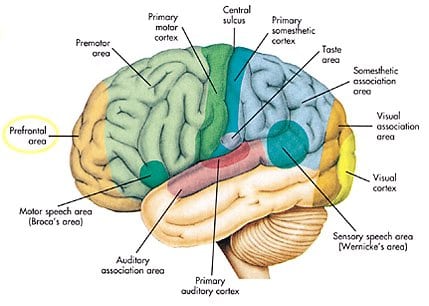Knowing how your brain works can boost your productivity
 A week ago Sunday was a dreary day in Paris and, freed from the urge to outside, I plunged head first into a fascinating book, John Medina’s Brain Rules. Medina is a developmental molecular biologist who has focused his research on how brain sciences influence how we learn and how we work. He writes in a lively, conversational style that makes this hugely complex field accessible to laymen.
A week ago Sunday was a dreary day in Paris and, freed from the urge to outside, I plunged head first into a fascinating book, John Medina’s Brain Rules. Medina is a developmental molecular biologist who has focused his research on how brain sciences influence how we learn and how we work. He writes in a lively, conversational style that makes this hugely complex field accessible to laymen.
You can get a peek at what the book is all about on www.brainrules.net.
In reading the book, I had a number of “light bulb moments”, making connections with tidbits and assembling them with new understanding. That is not surprising since
what we pay attention to is often profoundly influenced by memory… Different environments create different expectations…[Cultural differences] too can affect how a given audience perceives a given presentation or class lecture.
(pp. 75-76)
I highly recommend this book to anyone who seeks to understand and improve how they learn, how they work, or to gain insight in the type of intelligence their child displays and support its development.
Within Rule 4, Medina sets us straight on a modern myth.
In today’s IT-dominated and connected world and open space “hot-desking” office environments, effective multitasking is viewed as a key organizational skill to acquire and hone. It is also a quality many rely upon to juggle tightly packed agendas and achieve some sense of work/life balance.
Medina explains why effective multitasking is impossible, and moreover, how striving to multitask actually wastes time and causes potentially serious mistakes.
I fell for the multitasking hype like a fish takes to water. I come from a polychronic culture, which allows doing several things at once, places relationships over the task at hand, deals with interruptions without batting an eye-lash, and, to use Trompenaar’s term, views time as synchronization rather than as sequence. Polychronic cultures are typically high context cultures too, while monochronic cultures tend to be low context cultures.
The brain multitasks all the time: you can walk and chew gum, engage in a conversation with a friend while your brain is also making your heart pump blood through your body, you can feel hungry and tend to an interpersonal need at the same time.
Multitasking, when it comes to paying attention, is a myth. The brain naturally focuses on concepts sequentially, one at a time…[Paying attention] is the resource you forcibly deploy while trying to listen to a boring lecture at school. It is the activity that collapses as your brain wanders during a tedious presentation at work. This attentional ability is not capable of multitasking.
(pp. 84-85, emphasis mine)
So when you are working on a project and the phone rings, or you are speaking on the phone to a client and a family member walks into your office, what happens?
- Your sensory system picks up the distraction. Your brain has to disengage from what it is doing before it can respond. Your mental switchboard – the anterior prefrontal cortex – kicks in to alert the brain it is going to have to shift attention.
- Your brain sends another message to your mental switchboard that it needs to activate the right rules to respond (to the phone, to the family member…).
- Once the distraction is over, your brain needs to take each of these steps again, and then reactivate the rules so that your can return to the task that had your attention before.
These steps have to occur in sequence. It seems to happen quickly, but for the brain it takes a long time. If you mumble to yourself “Now, where was I?” or grumble to your spouse “Oh no! Look at what you made me do?”, you realize why multitasking is a myth.
The best you can say is that people who appear to be good at multitasking actually have good working memories, capable of paying attention to inputs one at a time.
Studies show that a person who is interrupted takes 50 percent longer to accomplish a task. Not only that, he or she makes up to 50 percent more errors….
(p.87)
Takeaway:
Multitasking can be effective to get chores done that don’t require a lot of attention – ironing while dictating a grocery list, washing the dishes while planning tomorrow in your head and so on.
But when you want to “work smart” and work well, let your brain focus. You’ll gain in productivity and quality.
Tags: brain rules, effectiveness, John Medina, linkedin, productivity





[…] This post was mentioned on Twitter by La Rassegna. La Rassegna said: â–ş Knowing how your brain works can boost your productivity: A week ago Sunday was a dreary day in Paris and, freed… http://bit.ly/djPrQ6 […]
Fascinating!
I wonder though if you can train your brain to multi-task *even* when you’re paying attention – speed up the sequence or something – when your circumstances force you to do so. Like if you’re a sleep-deprived translator mum with a teething toddler and a fast-approaching deadline. ‘Course you might have got in some practice playing action video games – see this article:
http://www.timesonline.co.uk/tol/life_and_style/health/article3639884.ece
It is a really tough call, because the brain works so quickly, we *think* we are able to concentrate doing things simultaneously. But Medina explains well that each step is in sequence. To really know what your brain is doing and what parts of it are being solicited, you’d need to be hooked up to special lab equipment. Try, for example, writing a careful business marketing email while *at the same time* having a telephone conversation with a friend. Both activities require attention, whereas writing that email while chewing gum only demands that you pay attention to the email. Try it! Let me know how the email turns out in both instances!
As to the video game example in that article – and mind you, I’m no expert – it seems to me that the brain is not multitasking in that instance: it is focused on “shooting as many enemies as possible before they shoot you”. The brain is not having to disconnect from one set of rules dealing with attention-demanding activity A to engage another set to deal with activity B – it is focused on getting those buggers!
The book is great fun and enlightening. If education, for example, were restructured along the lines Medina suggests, I think many of today’s seemingly intractable school-related issues would be solved.
If you want to improve your brain competitivity, I highly recommend having a look at http://www.lumosity.com .
[…] time to John Medina’s book Brain Rules, which I’d written about a few months ago here. It’s a […]